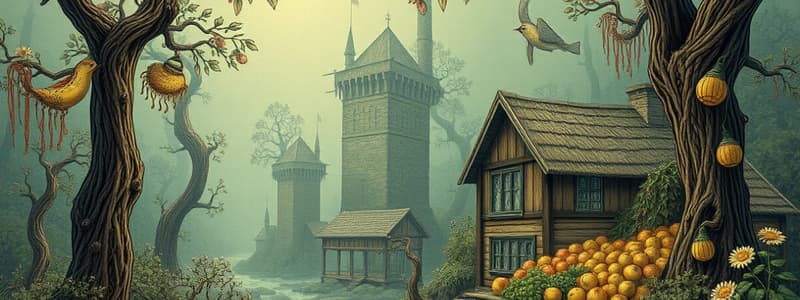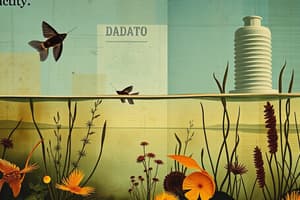Podcast
Questions and Answers
Describe the process of primary productivity.
Describe the process of primary productivity.
The rate at which solar energy (sunlight) is converted into organic compounds (such as sugars) over time.
Describe one short-term, direct effect that overharvesting crabs would have on the food web.
Describe one short-term, direct effect that overharvesting crabs would have on the food web.
The number of sea snails would increase.
Describe one potential realistic strategy to increase the population of crabs.
Describe one potential realistic strategy to increase the population of crabs.
Passing laws to cap the number of boats that can enter fisheries; passing laws to cap the number of crabs that can be harvested by each boat; improving existing habitat for crabs; creating habitat (sea grasses) for young crabs to escape predators; reducing pollution that can create dead zones, which can kill the organisms crabs can eat.
Which of the following best describes the movement of energy in an ecosystem?
Which of the following best describes the movement of energy in an ecosystem?
Which of the following is exemplified by the equations related to the nitrogen cycle?
Which of the following is exemplified by the equations related to the nitrogen cycle?
Which of the following best explains why terrestrial trophic pyramids usually do not have levels higher than tertiary consumers?
Which of the following best explains why terrestrial trophic pyramids usually do not have levels higher than tertiary consumers?
Which of the following best describes gross primary productivity in an ecosystem?
Which of the following best describes gross primary productivity in an ecosystem?
Which of the following best describes the net primary productivity of an ecosystem?
Which of the following best describes the net primary productivity of an ecosystem?
Explain why Forest A, with a net primary productivity of 1,650 kcal/m²/year, has lower rates of cellular respiration than Forest B, at 1,110 kcal/m²/year.
Explain why Forest A, with a net primary productivity of 1,650 kcal/m²/year, has lower rates of cellular respiration than Forest B, at 1,110 kcal/m²/year.
What is the best explanation for why there is such a small amount of phosphorus that moves into aquatic systems?
What is the best explanation for why there is such a small amount of phosphorus that moves into aquatic systems?
Which of the following best explains the steady movement of phosphorus between biological organisms and soil in an undisturbed system?
Which of the following best explains the steady movement of phosphorus between biological organisms and soil in an undisturbed system?
Based on the diagram, which of the following reservoirs contains the most phosphorus?
Based on the diagram, which of the following reservoirs contains the most phosphorus?
What biome contains plants that are adapted to prevent water loss due to low average rainfall and high temperatures?
What biome contains plants that are adapted to prevent water loss due to low average rainfall and high temperatures?
Which of the following statements is true of aquatic biomes?
Which of the following statements is true of aquatic biomes?
Which biome is best characterized as an area that forms a narrow band along the coast, experiencing daily changes in sunlight, temperature, and water?
Which biome is best characterized as an area that forms a narrow band along the coast, experiencing daily changes in sunlight, temperature, and water?
What explains why different species of warblers can inhabit the same conifer trees?
What explains why different species of warblers can inhabit the same conifer trees?
Where is the majority of fresh water found on Earth?
Where is the majority of fresh water found on Earth?
What biome is characterized by long dry seasons and is dominated by grasses, shrubs, and grazing animals?
What biome is characterized by long dry seasons and is dominated by grasses, shrubs, and grazing animals?
Flashcards are hidden until you start studying
Study Notes
Primary Productivity
- Primary productivity refers to the rate at which solar energy is transformed into organic compounds, especially sugars, over time by producers.
Effects of Overharvesting
- Overharvesting crabs directly increases the population of sea snails by eliminating a key predator in the food web.
Strategies to Increase Crab Populations
- Implementing laws to restrict the number of boats in fisheries.
- Capping the number of crabs harvested per boat.
- Enhancing existing crab habitats.
- Creating new habitats, such as sea grass beds, to protect young crabs from predators.
- Reducing pollution to prevent dead zones affecting food availability for crabs.
Energy Movement in Ecosystems
- Energy is captured by producers and decreases as it moves up trophic levels, indicating energy loss during transfer.
Nitrogen Cycle and Conservation of Matter
- Biogeochemical cycles like the nitrogen cycle exemplify the principle of conservation of matter, where matter is neither created nor destroyed.
Terrestrial Trophic Pyramids
- Trophic pyramids typically don’t extend past tertiary consumers due to significant energy loss as heat, making it unsustainable to support further levels.
Gross and Net Primary Productivity
- Gross primary productivity (GPP) measures total solar energy captured by producers through photosynthesis.
- Net primary productivity (NPP) is calculated by subtracting energy lost through respiration from GPP.
Forest Productivity Comparison
- Forest A has a higher net primary productivity (1,650 kcal/m²/year) than Forest B (1,110 kcal/m²/year), indicating lower respiration rates in Forest A.
Phosphorus Cycle Movement
- Phosphorus moves slowly into aquatic systems because it lacks a gaseous phase, minimizing its transition to oceanic reservoirs.
Steady State in Phosphorus Movement
- Steady-state movement of phosphorus between organisms and soil occurs as organic phosphorus is assimilated by plants.
Phosphorus Reservoirs
- The largest reservoir of phosphorus is found in sediments.
Desert Biome Characteristics
- Deserts have plants adapted to minimize water loss, thriving in low rainfall and high temperatures.
Aquatic Biomes Importance
- Freshwater biomes are crucial as vital sources of drinking water for ecosystems and human populations.
Intertidal Zones
- Intertidal zones are characterized by fluctuating environmental conditions, including sunlight, temperature, and water levels.
Resource Partitioning in Warblers
- Five species of warblers coexist in the same conifer trees through resource partitioning of seeds, minimizing competition while utilizing different tree areas.
Freshwater Distribution on Earth
- The majority of Earth’s freshwater is stored in ice caps and glaciers.
Savanna Biome Features
- Savannas are known for extended dry seasons, dominated by grasses, shrubs, and grazing animals.
Studying That Suits You
Use AI to generate personalized quizzes and flashcards to suit your learning preferences.





